Shells of the brain
Last reviewed: 23.04.2024

All iLive content is medically reviewed or fact checked to ensure as much factual accuracy as possible.
We have strict sourcing guidelines and only link to reputable media sites, academic research institutions and, whenever possible, medically peer reviewed studies. Note that the numbers in parentheses ([1], [2], etc.) are clickable links to these studies.
If you feel that any of our content is inaccurate, out-of-date, or otherwise questionable, please select it and press Ctrl + Enter.
The brain, as well as the dorsal one, is surrounded by three medullary membranes. These connective tissue sheets (membranes) cover the brain. The outermost of these shells is the hard shell of the brain. It is followed by an average - arachnoid, and inside it is the inner soft (vascular) membrane of the brain, adjacent to the surface of the brain.
Hard shell of the brain
This shell is characterized by a special density, the presence in its composition of a large number of collagen and elastic fibers. The hard shell of the brain from the inside lining the skull cavity, at the same time is the periosteum of the inner surface of the bones of the cerebral part of the skull. With the bones of the roof (roof) of the skull, the hard shell of the brain is bound together and it is easy to separate from them. In the area of the base of the skull, the membrane is firmly fused to the bones. A hard shell surrounds the cranial nerves emerging from the brain, forming their vagina and fusing with the edges of the holes through which these nerves leave the cranial cavity.
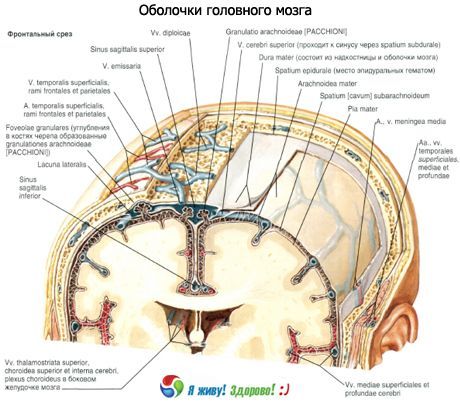
On the inner base of the skull (in the region of the medulla oblongata), the solid membrane of the brain fuses with the edges of the large occipital foramen and continues into the hard shell of the spinal cord. The inner surface of the hard shell, facing the brain (to the arachnoid membrane), is smooth, covered with flat cells. In some places, the solid membrane of the brain is split. Its inner sheet (duplication) is deeply entangled in the form of processes in the cracks that separate parts of the brain from each other. In the areas of outbreaks of sprouts (at their base), as well as in areas where the hard shell attaches to the bones of the inner base of the skull, in the cleavages of the hard shell of the brain, triangular channels are formed, lined with the endothelium, - sinuses of the dura mater (sinus durae matris)
The largest process of the hard shell of the brain is located in the sagittal plane and penetrating into the longitudinal slot of the large brain between the right and left hemispheres of the crescent brain, or large crescent process (falx cerebri). It is a thin crescent-shaped plate of a hard shell that penetrates in the form of two leaves into the longitudinal slit of the large brain. Not reaching the corpus callosum, this plate separates the right and left cerebral hemispheres from each other. In the split base of the cerebral cirrus, which in its direction corresponds to the sulcus of the superior sagittal sinus of the cranial vault, the upper sagittal sinus lies. In the thickness of the free edge of the cerebral crescent there is a lower sagittal sinus between its two sheets. At the front, the sickle of the great brain is fused with the cock's crest of the latticed bone. The posterior section of the sickle at the level of the inner occipital protrusion fuses with the hint of the cerebellum. In the line of fusion of the posterior margin of the cerebellum sickle and the nerve of the cerebellum in the cleavage of the solid membrane of the brain there is a straight sine connecting the lower sagittal sinus with the superior sagittal, transverse and occipital sinuses.
The nemet (tent) of the cerebellum (tentorium cerebelli) hangs in the form of a two-tented tent above the posterior cranial fossa, in which the cerebellum lies. Penetrating into the transverse slit, the nerve of the cerebellum separates the occipital lobes of the large brain from the hemispheres of the cerebellum. The anterior margin of the cerebellum is uneven. It forms the incision of the incense (incisura tentorii), to which the trunk of the brain is in front.
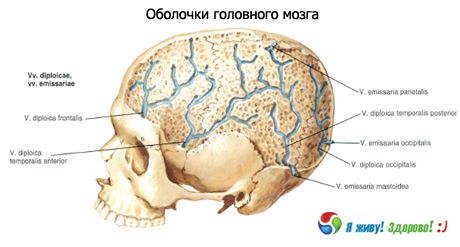
The lateral margins of the nascent of the cerebellum are intertwined with the upper edge of the pyramids of the temporal bones. At the rear, the cerebellum grows into a hard shell of the brain, which lines the occipital bone from the inside. At the site of this transition, the hard shell of the brain forms a splitting - a transverse sinus adjacent to the same groove of the occipital bone.
The cerebellum sickle, or small sickle-shaped process (falx cerebelli), like the large-brain sickle, is located in the sagittal plane. Its anterior margin is free and penetrates between the hemispheres of the cerebellum. The posterior margin (base) of the cerebellum sickle extends to the right and left into the hard shell of the brain from the inner occipital projection at the top to the posterior edge of the large occipital orifice at the bottom. At the base of the cerebellum sickle, the occipital sinus is formed.
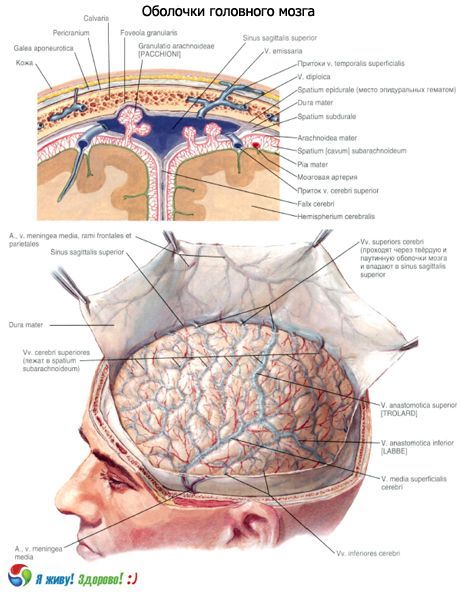
Diaphragm (Turkish) saddle
(diaphragma sellae) is a horizontally located plate with an opening in the center, stretched over the hypophyseal fovea and forming its roof. Under the diaphragm of the saddle in the pit is the pituitary gland. Through the hole in the diaphragm, the pituitary gland is connected to the hypothalamus by means of a funnel.
Sinuses (sinuses) of the solid membrane of the brain
Sinuses (sinuses) of the hard shell of the brain, formed by splitting the shell into two plates, are the channels through which venous blood flows from the brain into the internal jugular veins.
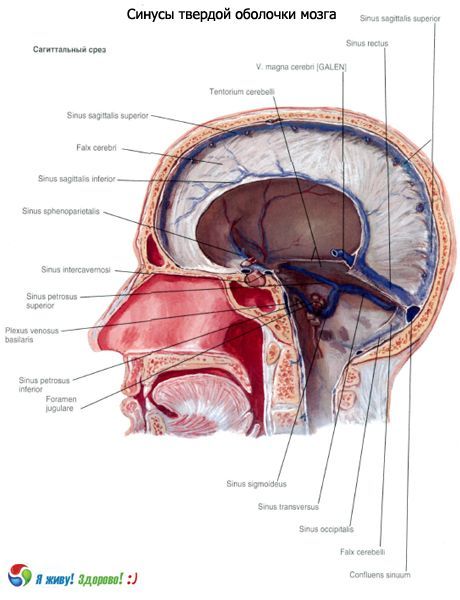
Sheets of the hard shell, forming a sinus, are tightly stretched and do not subside. Therefore, on the cut, the sinuses gap. Valves do not have sinuses. This structure of the sinuses allows venous blood to flow freely from the brain, regardless of the fluctuations in intracranial pressure. On the inner surfaces of the bones of the skull, at the locations of the sinuses of the hard shell, there are corresponding furrows. Distinguish the following sinuses of the hard shell of the brain.
- The superior sagittal sinus (sinus sagittalis superior) is located along the entire outer (upper) edge of the cerebral crescent, from the cock's crest of the latticed bone to the inner occipital protrusion. In the anterior sections this sinus has anastomoses with the veins of the nasal cavity. The posterior end of the sine runs into the transverse sinus. To the right and to the left of the superior sagittal sinus lie the lateral lacunae associated with it (lacunae laterales). These are small cavities between the outer and inner layers (sheets) of the hard shell of the brain, the number and dimensions of which are very variable. The cavities of the lacunas communicate with the cavity of the superior sagittal sinus, they contain the veins of the hard shell of the brain, the veins of the brain and the dyschic veins.
- The lower sagittal sinus (sinus sagittalis inferior) is located in the thickness of the lower free margin of the cerebellum sickle. It is much smaller than the upper one. With its posterior end, the inferior sagittal sinus flows into a straight sine, into its anterior part, in the place where the lower edge of the cerebral crescent is fused with the anterior margin of the cerebellum nematode
- Direct sinus (sinus rectus) is located sagittally in the splitting of the nerve of the cerebellum along the line of attachment to it of the sickle sickle. A straight sine connects the posterior ends of the upper and lower sagittal sinuses. In addition to the inferior sagittal sinus, a large vein of the brain flows into the anterior end of the rectus sinus. At the back of the line, the sine flows into the transverse sine, into its middle part, called the sinus drainage. Here, the posterior part of the superior sagittal sinus and the occipital sinus also flow.
- The transverse sinus (sinus transversus) lies in the place of retreatment from the hard shell of the brain to the nerve of the cerebellum. On the inner surface of the scales of the occipital bone, this sinus corresponds to a wide sulcus of the transverse sinus. That place, in which the upper sagittal, occipital and straight sinuses flow into it, is called a sinus drain (confluens sinuum, fusion of sinuses). On the right and left, the transverse sinus continues into the sigmoid sinus of the corresponding side.
- The occipital sinus (sinus occipitalis) lies in the base of the cerebellum sickle. Descending along the inner occipital crest, this sine reaches the posterior edge of the large occipital foramen, where it divides into two branches, covering this hole and from the sides. Each of the branches of the occipital sinus runs into the sigmoid sinus of its side, and the upper end into the transverse sinus.
- Sigmoid sinus (sinus sigmoideus) paired, located in the eponymous sulcus on the inner surface of the skull, has an S-shaped shape. In the area of the jugular aperture, the sigmoid sinus passes into the internal jugular vein.
- The cavernous sinus (sinus cavernosus) is paired, located on the base of the skull on the side of the Turkish saddle. Through this sine pass the internal carotid artery and some cranial nerves. Sine has a very complex design in the form of communicating with each other caves, in connection with which it received its name. Between the right and left cavernous sinuses there are messages (anastomoses) in the form of the anterior and posterior intercellular sinus (sinus intercavernosi), which are located in the thickness of the diaphragm of the Turkish saddle, in front and behind the funnel of the pituitary gland. In the anterior sections of the cavernous sinus, the wedge-parietal sinus and the superior ocular vein fall.
- The wedge-parietal sinus (sinus sphenoparietalis) is paired, is attached to the free posterior margin of the small wing of the sphenoid bone, which in the cleavage is attached here by the hard shell of the brain.
- The upper and lower stony sinuses (sinus petrosus superior et sinus petrosus inferior) are paired, located along the upper and lower margins of the pyramid of the temporal bone. Both sinuses participate in the formation of ways of outflow of venous blood from the cavernous sinus into the sigmoid. The right and left lower stony sines are joined by a few veins lying in the cleavage of the hard shell in the region of the occipital body, which are called the basilar plexus. This plexus is connected to the internal vertebral venous plexus through the large occipital foramen.
In some places, the sinuses of the hard shell of the brain form anastomoses with the external veins of the head with the help of emissary veins - graduates (vv. Emissariae). In addition, the sinuses of the hard shell have messages with diplic veins (vv. Diploicae) located in the spongy substance of the bones of the cranial vault and flowing into the superficial veins of the head. Thus, the venous blood from the brain flows through the systems of its superficial and deep veins into the sinuses of the hard shell of the brain and further into the right and left internal jugular veins.
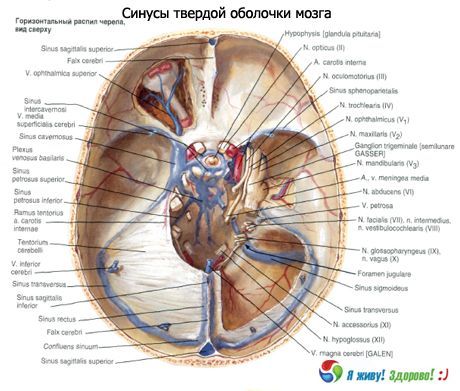
In addition, due to anastomoses of sinuses with diplic veins, venous graduates and venous plexuses (vertebral, basilar, under the occipital, pterygoid, etc.) venous blood from the brain can flow into the superficial veins of the head and neck.
Vessels and nerves of the solid membrane of the brain
A middle meningeal artery (branch of the maxillary artery) that branched into the temporomandibular part of the membrane approaches the hard shell of the brain through the right and left awning holes . The hard shell of the brain lining the anterior cranial fossa, is supplied by the branches of the anterior meningeal artery (branch of the anterior articular artery from the eye artery). In the shell of the posterior cranial fossa, the posterior meningea artery branches, the branch of the ascending pharyngeal artery from the external carotid artery penetrating into the cranial cavity through the jugular opening, as well as the meningeal branches from the vertebral artery and the mastoid branch from the occipital artery entering the cranial cavity through the mastoid aperture.
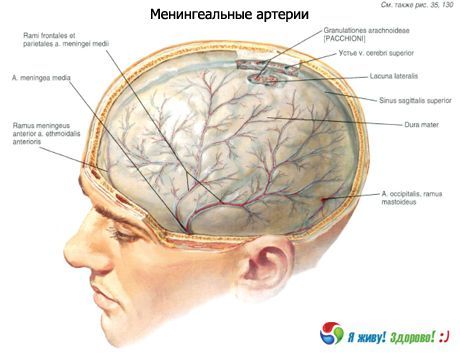
The veins of the soft shell of the brain flow into the nearest sinuses of the hard shell, as well as into the pterygoid venous plexus.
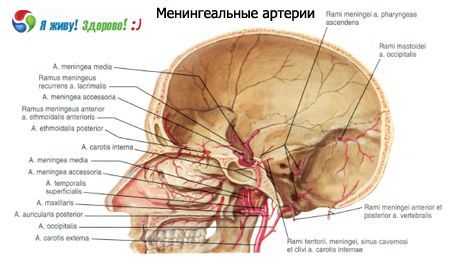
The hard shell of the brain is innervated by the branches of the trigeminal and vagus nerves, as well as by sympathetic fibers entering the envelope in the thickness of the advent of the blood vessels. In the area of the anterior cranial fossa, she receives branches from the optic nerve (the first branch of the trigeminal nerve). The branch of this nerve - the tentorial (shell) branch - also supplies the nerve of the cerebellum and the sickle of the large brain. The middle meningeal branch from the maxillary nerve, as well as the branch from the mandibular nerve (respectively, the second and third branches of the trigeminal nerve) approach the membrane in the middle cerebral fossa.
The spiderweb of the brain
The spiderweb of the brain (arachnoidea mater encephali) is located inside the hard shell of the brain. A thin, transparent arachnoid membrane, unlike a soft shell (vascular), does not penetrate into the gap between individual parts of the brain and into the furrows of the hemispheres. It covers the brain, moving from one part of the brain to another, and lies over the furrows. From the soft shell of the brain, the arachnoid is separated by a subarachnoid (subarachnoid) space (cavitas subaracnoidalis), which contains cerebrospinal fluid. In places where the arachnoid membrane is located over wide and deep furrows, the subarachnoid space is enlarged and forms sub-paotic cisterns (cisternae subarachnoideae) to a greater or lesser extent.
Above the convex parts of the brain and on the surface of the gyri, the arachnoid and soft membranes are closely adjacent to each other. In such areas the subarachnoid space considerably narrows, turning into a capillary gap.
The largest subarachnoid cisterns are the following.
- The cerebellar cerebral cistern (cisterna cerebellomedullaris) is located in the depression between the medulla oblongata and the dorsal cerebellum. At the back, it is bounded by a spider web. This is the largest of all tanks.
- The cisterna of the lateral fovea of the large brain (cisterna fossae lateralis cerebri) is located on the inferior side surface of the cerebral hemisphere in the eponymous pit, which corresponds to the anterior sections of the lateral groove of the cerebral hemisphere.
- Cisterna cross (cisterna chiasmatis) is located on the basis of the brain, anterior to the optic crossover.
- Mezhdozhkovaya cistern (cisterna interpeduncularis) is defined in the intercostal fossa between the legs of the brain, down (front) from the rear perforated substance.
The subarachnoid space of the brain in the region of the large occipital foramen communicates with the subarachnoid space of the spinal cord.
Spinal (cerebrospinal) fluid
Cerebrospinal fluid (liquor cerebrospinalis), formed in the ventricles of the brain, is poor in protein substances, there are no cells in it. The total amount of this liquid is 100-200 ml. It is produced by the vascular plexuses of the lateral, III and IV ventricles from their blood capillaries. Walls of blood capillaries, basal membrane, epithelial plate covering capillaries, form the so-called blood - brain barrier. This barrier from the blood in the cavity of the ventricles selectively passes certain substances and delays others, which is an important circumstance for protecting the brain from harmful effects.
From the lateral ventricles through the right and left interventricular (monrove) orifices spinal fluid enters the third ventricle, where there is also a vascular plexus. From the third ventricle, spinal fluid enters the IV ventricle through the cerebral waterway and then flows through the unpaired opening in the back wall (Magendi's opening) and the paired lateral aperture (Lushka's hole) into the cerebellar-cerebral cistern of the subarachnoid space.
The spiderweb connects to the soft shell lying on the surface of the brain with numerous thin bundles of collagen and elastic fibers, between which there are blood vessels. Near the sinuses of the hard shell of the brain, the arachnoid membrane forms peculiar outgrowths, protrusions - granulations of the arachnoid shell (granulationes arachnoideae; pachyon granulations). These protrusions protrude into the venous sinuses and lateral lacunae of the hard shell. On the inner surface of the bones of the skull, at the site of the granulation of the arachnoid membrane, there are impressions - the dimples of the granulations, where the outflow of cerebrospinal fluid to the venous bed occurs.
The soft (vascular) membrane of the brain (pia mater encephali)
This is the innermost shell of the brain. It is densely attached to the outer surface of the brain and comes into all the cracks and furrows. The soft shell consists of a loose connective tissue, in the thickness of which there are blood vessels that go to the brain and feed it. In certain places, the soft membrane penetrates the cavities of the ventricles of the brain and forms the vascular plexuses (plexus choroideus), which produce the cerebrospinal fluid.
Age features of the membranes of the brain and spinal cord
The hard shell of the brain in a newborn is thin, tightly fused to the bones of the skull. The shell processes are poorly developed. Sinuses of the hard shell of the brain are thin-walled, relatively wide. The length of the superior sagittal sinus in the newborn is 18-20 cm. The sinuses are projected differently than in the adult. For example, the sigmoid sinus is 15 mm posterior to the tympanic ring of the external auditory canal. There is a greater asymmetry in sine sizes than in an adult. The anterior end of the superior sagittal sinus anastomoses with the veins of the nasal mucosa. After 10 years, the structure and topography of the sinuses are the same as in the adult.
The spiny and soft membranes of the brain and spinal cord of the newborn are thin, tender. Subarachnoid space is relatively large. Its capacity is about 20 cm 3, it increases quite rapidly: by the end of the first year of life up to 30 cm 3, by 5 years - up to 40-60 cm 3. At children of 8 years the volume of subarachnoid space reaches 100-140 cm 3, in an adult it is 100-200 cm 3. Cerebellar-cerebral, mezhnozhkovaya and other cisterns on the basis of the brain in the newborn are quite large. Thus, the height of the cerebellum-cerebral cistern is about 2 cm, and its width (at the upper boundary) is from 0.8 to 1.8 cm.


 [
[